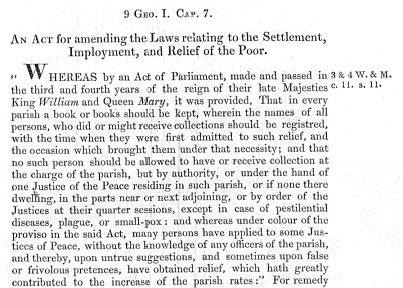The 1723 Poor Relief Act
The Poor Relief Act of 1722-3 An Act for amending the Laws relating to the Settlement, Imployment, and Relief of the Poor came into operation on 25 March 1723. It is sometimes known as Knatchbull's Act, after its parliamentary sponsor Sir Edward Knatchbull. It is also often referred to as the Workhouse Test Act because it embodied the principle that the prospect of the workhouse should act as a deterrent and that poor relief could only be made available to those who were desperate enough to accept its regime.
Parishes often adopted Knatchbull's Act in the belief that it would reduce the demand for poor relief, and thus the parish poor rates, especially if the workhouse was the only form of relief on offer. Parishes could also operate a mixed system, with 'deserving' claimants such as the elderly or chronic sick being given out-relief (hand-outs in cash or kind), while support for claimants such as the able-bodied could be limited to the workhouse.
Knatchbull's Act is widely regard as having kick-started the widespread use of workhouses. By the mid-1770s, around two thousand parish workhouses were in operation in England and Wales. It is worth remembering, though, that the great majority of parishes did not run a workhouse, preferring to relieve their poor only through out-relief.
To read the full text of the 1723 Act, just click on the picture of the title page above.
Unless otherwise indicated, this page () is copyright Peter Higginbotham. Contents may not be reproduced without permission.



